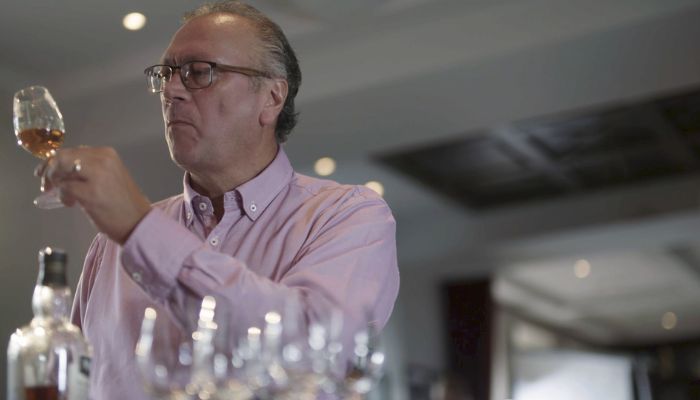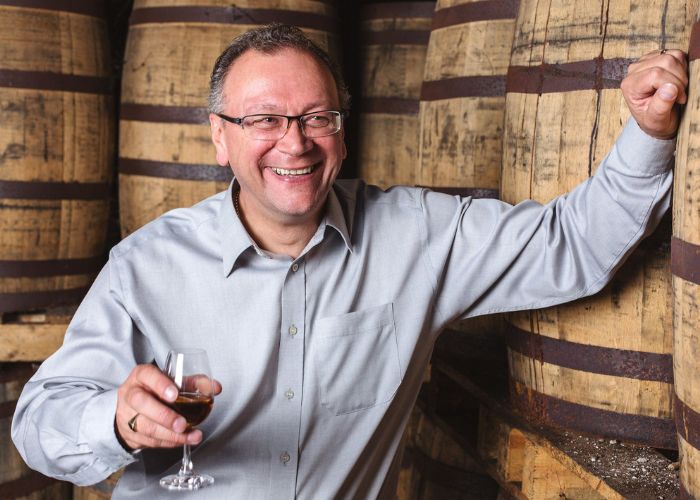Super Early Deadline
30 November 2025
Judging
Date
24 & 25 March 2026
Winners Announcement
22 April 2026
30 November 2025
24 & 25 March 2026
22 April 2026

Billy Leighton has had a long and illustrious career at Irish Distillers, with many more years to come. With well-known brands like Jameson, Redbreast, Knappogue Castle, and more under his wing, he has a new challenge to face every day.
As Master Blender to a company that houses some of the world’s top Irish whiskies in the world, he has nothing short of a demanding task at hand. But Billy Leighton, who has been doing this for 46 years now, makes it look like a walk in the park.
I began working for Irish Distillers in 1976 as a trainee accountant. My time working in finance gave me strong background knowledge about the functions of each department, and one day in 1988 I showed my interest in working in production. The very next day I brought in my safety shoes and got started!
Once I had the opportunity to get involved with the day-to-day operations, I thrived from being able to share my passion for the whiskeys made at Midleton Distillery and to learn from the skilled production teams. As the years went by, my responsibilities grew and I began working in blending, warehousing, maturation, and distilling. I was appointed as Deputy Chief Blender in 2003 and became Master Blender in May 2004.

We have a 360-degree vision for all our brands, and we keep them all in mind as we review our inventory profile. We monitor what’s happening operationally on a day-to-day basis and then look at future plans to meet demands for our range of whiskeys.
By its nature, the role is varied. The first thing I would do each day is to review what happened the previous day, monitoring operational movements and cask movements. Dave McCabe and Deirdre O’Carroll take care of the day-to-day laboratory work, but there have been days when I might be screening close to 300 cask samples.
Innovation and new product development is a big element of our roles. We look at all the brands, and ensure we’re making the right distillate types, filling the right percentage of each into different cask types, and keeping control of the profile of our inventory to meet all demands.
Planning is the key to blending, and we’re planning our inventory as far ahead as the next 40 years.
As Blender, I would be very close to the construction of each product, so there are certain elements I would be looking for to varying degrees depending on the brand. Each of the brands has its own particular style so whenever it comes to innovation we are building on the heritage of the brand.
The challenge of creating a new product and innovating new whiskeys is one of the most enjoyable aspects of the role. One of the rewards of this challenge is coming up with an idea in your head and turning it into an exciting new whiskey, and then seeing a favourable reaction when it is launched to the public.
In terms of surprises, I am always surprised by people coming to events such as Whiskey Live and wanting to talk with me, sharing my enthusiasm for our whiskeys and for the Irish whiskey category. That will never get old.
[[relatedPurchasesItems-63]]
I’m not sure that the craft has changed a whole lot. Things have changed for sure, from a production point of view with new technologies, but the essence of the craft very much has stayed true. The nosing, the tasting, that will never change.
The quality of the casks we use is as important as the quality of the distillate we fill into them. We take special care over the quality of the casks we procure, whether they be from America or traditional fortified wine casks from Europe. For me, as Blender, this gives me the confidence that the mature product will meet my expectations. We cycle the casks three times and each cycle offers different characteristics to work with. So, taking all the permutations of spirit type, cask type, and age, it makes it possible for us to create a range of products each with a unique formulation.
Right now, we are experimenting with all sorts of casks – the technical file allows us to experiment with different types of wood, for example, we have had recent releases using sweet chestnut and wild cherry.
It all revolves around quality. The role of Master Blender involves ensuring that everything is in place, by way of spirit type, cask type, and age profile of a stock, in order that we can maintain consistent high quality across our range of whiskeys.

Since 2010, we have invested over €100 million to improve our operational efficiency and we are now focused on implementing projects which will significantly reduce and ultimately remove carbon emissions across our operations at Midleton Distillery. These projects are being implemented as part of an additional €50 million investment. Innovative, ground-breaking technology will help us to reach our goal. Every possible opportunity for reducing emissions is considered - from improving energy generation efficiency to recycling waste heat in the distillation process.
Of course, there will always be work to do to reduce emissions across our entire supply chain. Our suppliers and grain growers are essential to achieving our ambitions and we have already seen great progress through collaboration. We are working with our packaging partners to ensure that by the end of 2025, all Irish Distillers’ secondary packaging will be recyclable, reusable, compostable or removed. When it comes to growing barley used in the production of our whiskeys, over 300 growers are participating in our Sustainable Green Spring Barley Scheme which aims to improve the economic sustainability of the spring barley sector; supports spring barley farmers in reducing CO2 footprint and enhances biodiversity on Irish tillage farms.
Many aspects of the whiskey-making process are circular by nature: our feed recovery plant manufactures animal feed from the by-products of whiskey production. Residual materials from brewing and distilling are used to make nutrient-dense animal feed used by Irish farmers to feed livestock, meaning there is virtually no organic waste arising from distillation. Casks of course are usually pre-seasoned and have already been used in the bourbon, sherry, and wine industries. The majority of our barrels are sourced in the USA, France and Spain. Some barrels are even used again after they have matured Irish whiskey by other spirit industries. So as an industry, we significantly increase the lifespan of a barrel.
When we are creating new releases, sustainability is at the top of our minds. For our Midleton Very Rare Dair Ghaelach Series we had two clear objectives from the very start; to ensure that any Irish oak used would be sourced from a sustainable supply and that maturation of a single pot still Irish whiskey in native oak would produce a whiskey of outstanding quality. We collaborated with the internationally recognised Association Futaie Irréguliére (AFI) and professional foresters, whose craftspeople have continued to guide us on the sourcing, felling and long-term sustainability of Irish oak. Together, we have helped ensure that the economic, environmental, and social fabric of Ireland’s countryside will be preserved. For example, the forest management practised in Kylebeg Wood has contributed to the reappearance of the pine marten in the Laois countryside. This in turn has impacted the alien grey squirrel and helped the native red squirrel, which had practically vanished from the local area.
The goal always is to guarantee the supply of high-quality whiskeys.

METHOD AND MADNESS emerged as a way for us to experiment and learn from new innovations, methods, and flavours, and yes, we’ve had a lot of fun doing it! We often refer to the Micro Distillery as our playground for innovation to run free.
We are constantly innovating and trying new things at the distillery – but you’ll have to stay tuned for those!
It’s the anticipation for me. It’s knowing that there are people who love our work, and who enjoy what we do. It gives me great satisfaction.
The first step is getting into the business. Our graduate programme at Irish Distillers is a great example, and also being knowledgeable about the industry and the whiskeys is always a big help.
To become a blender, you need to hone your senses, your nose, and your taste, and this takes practice. Be curious and experiment, not just with whiskey but with everything. Don’t be shy to describe what you’re tasting or smelling, as the more you taste different things, the more you’re training your senses to pick up on notes and flavours and expanding your own vocabulary to describe them.
I would be enjoying Powers John’s Lane, it’s one for the rockers so I would be listening to Nazareth, Tom Petty, Fleetwood Mac, Credence Clearwater Revival, or Bob Seger.

In conversation with Malvika Patel, Editor and VP, Beverage Trade Network
Show your spirits where it matters. Get your products tasted by top bartenders, buyers and experts at the London Competitions — enter now.